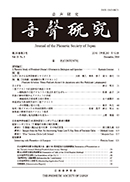Volume 21, Issue 3
Displaying 1-13 of 13 articles from this issue
- |<
- <
- 1
- >
- >|
Research Articles
-
2017 Volume 21 Issue 3 Pages 1-14
Published: December 30, 2017
Released on J-STAGE: April 27, 2018
Download PDF (1125K) -
2017 Volume 21 Issue 3 Pages 15-21
Published: December 30, 2017
Released on J-STAGE: April 27, 2018
Download PDF (252K)
Feature Articles: Progress in the Study of Filled Pauses
-
2017 Volume 21 Issue 3 Pages 22-23
Published: December 30, 2017
Released on J-STAGE: April 27, 2018
Download PDF (165K) -
2017 Volume 21 Issue 3 Pages 24-32
Published: December 30, 2017
Released on J-STAGE: April 27, 2018
Download PDF (377K) -
2017 Volume 21 Issue 3 Pages 33-40
Published: December 30, 2017
Released on J-STAGE: April 27, 2018
Download PDF (512K) -
2017 Volume 21 Issue 3 Pages 41-52
Published: December 30, 2017
Released on J-STAGE: April 27, 2018
Download PDF (856K) -
2017 Volume 21 Issue 3 Pages 53-62
Published: December 30, 2017
Released on J-STAGE: April 27, 2018
Download PDF (661K) -
2017 Volume 21 Issue 3 Pages 63-73
Published: December 30, 2017
Released on J-STAGE: April 27, 2018
Download PDF (3381K)
Tribute
-
2017 Volume 21 Issue 3 Pages 74-80
Published: December 30, 2017
Released on J-STAGE: April 27, 2018
Download PDF (509K)
Summaries of Presentations at the Thirty first General Meeting
-
2017 Volume 21 Issue 3 Pages 81-91
Published: December 30, 2017
Released on J-STAGE: August 16, 2018
Download PDF (722K)
Summaries of Talks at the 336th Regular Meeting
-
2017 Volume 21 Issue 3 Pages 92-93
Published: December 30, 2017
Released on J-STAGE: August 16, 2018
Download PDF (280K)
Administrative Reports
-
2017 Volume 21 Issue 3 Pages 112-118
Published: December 30, 2017
Released on J-STAGE: April 27, 2018
Download PDF (399K)
Erratum
-
2017 Volume 21 Issue 3 Pages 121
Published: December 30, 2017
Released on J-STAGE: April 27, 2018
Download PDF (120K)
- |<
- <
- 1
- >
- >|
